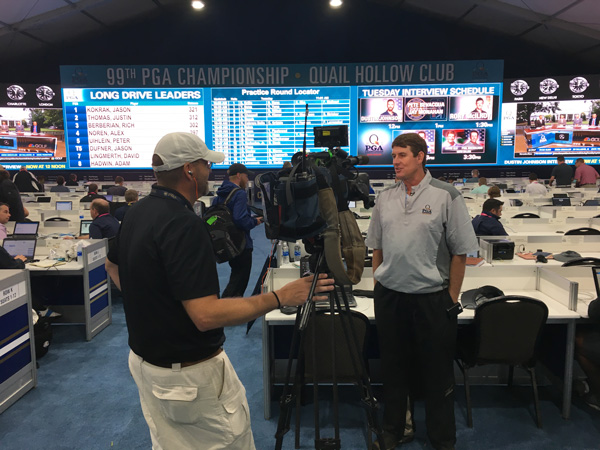Another tournament time for Keith Wood
Quail Hollow Superintendent Keith Wood is getting his first taste of hosting a major championship this week, but it’s hardly his first experience with tournament golf.
Wood’s initial experience with tournament golf was at his first superintendent job in 2002 at Florence (S.C.) Country Club. The private club hosted a PGA Tour Qualifying School event, and that opportunity is what Wood says got him “hooked” on tournament golf.
After more than five year in Florence, the 1998 Rutgers University turf school graduate moved onto Sedgefield Country Club, Greensboro, N.C. There he became the host superintendent of the PGA Tour’s Wyndham Championship and learned more about tournament golf.
During his more than seven years at the Donald Ross-designed course, he oversaw a greens renovation and change to bermudagrass, which, “caught some people’s attention,” according to Wood.
In May 2015, Wood got the call to host his first major when he was offered and accepted the job at Quail Hollow, the home of the PGA Tour event the Wells Fargo Championship, and the host venue of the 2017 PGA Championship. The job came with three assistant superintendents that had been there for multiple years already, and Wood says he “can’t say enough about them.”
“The fact that they’re still here and they’re pushing as hard as they can push says a lot about their character, and their love of the club,” says Wood of assistants Brandon Hicks, Basil Lowell and Shane Oman. “For them they have been here the last four to five years, which a lot has gone on. You know they’ve seen the Green Mile get rebuilt. They’ve seen changes on No. 13. They’ve been through a couple of renovations from bentgrass to bermudagrass. Now they’ve seen the completion of Mr. Fazio’s master plan.”
He adds that working with the famed architect Tom Fazio is “amazing” because he takes in consideration what a superintendent and his crew can handle into his designs, but Wood doesn’t want that to hold the architect back.

Wood was a popular interview during the PGA Championship, appearing on national television and seen here with a local Charlotte network in the media tent.
“This summer there would be times where he would look at me and say, ‘Hey, if we design it this way can you maintain it?’ I’ll say, ‘Absolutely we can maintain it. In fact, I would challenge you to be a little more aggressive with your design and challenge us to step our game up in the maintenance,’” says Wood. “We want his design to be special as well. So don’t hold back on any of your design processes because you think we can’t maintain it.”
One of the biggest changes to the course was the switch from bentgrass greens to Champion Ultradwarf bermudagrass, a turf type that Wood seems to have a special ability to maintain.
“I wouldn’t say I’m an expert, but what I will say is that Champion suits me as a superintendent because I’m a hands-on superintendent,” says Wood. “I like to think that I have a good grass intuition. I don’t know if anyone has ever said that before.”
Another difference for the PGA Championship compared to the Well Fargo Championship will be the course’s setup.
“Our fairway contours are going to be different than they were for the Wells Fargo. Mowing heights will be a little bit different,” says Wood. “Of course the golf course is going to be very different. A 100 percent bermudagrass golf course in August is going to play much different due to the August heat and humidity and grass type than it does in May with cooler, little dryer air and ryegrass golf course. So the turf type is going to be a tremendous change for the players. None of the pros have played this golf course before.”
The Quail Hollow maintenance staff will be missing a team member that it typically would for the Well Fargo, a PGA Tour agronomist. Wood says having that turf professional around during a tournament is a “luxury” because the person helps him make a lot of decisions as far as bridging the gap between what the tournament director wants and the superintendent provides.
“So that would mean the tournament director wanting the rough to be a little bit deeper or the opposite and he’ll take that to the Tour agronomist and tell the Tour agronomist how they want it to play. The Tour agronomist will help the superintendent implement those practices,” says Wood. “The PGA of America, they don’t have that person. So, it’s on the shoulders of the superintendent to make sure we understand what the playing conditions are and what the tournament director wants.”
Even without the assistance of a Tour agronomist he is excited for the championship, and when asked if he loves his job, Wood simply answered, “Absolutely, I couldn’t imagine doing anything else.”









